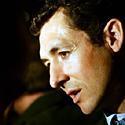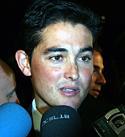
Recently on Cyclingnews.com |
60th Vuelta a España - GT
Spain, August 27-September 18, 2005
Route announcement: Vuelta 2005 course has climbers smiling
By Shane Stokes in Madrid

|
The likely protagonists of next year's Vuelta today pronounced themselves happy with the look of the route for the 2005 edition, with more than enough mountains featuring to guarantee a humdinger of a race. Riders such as 2004 winner Roberto Heras, Alejandro Valverde, Oscar Sevilla and Joseba Beloki all gave the route the thumbs up at today's launch in Madrid's Auditorio de IFEMA in the Parque Ferial Juan Carlos I.
"It is a typical route for the Vuelta. With the Pyrenees and Asturias, I think it is a good tour for me," said three-time winner Roberto Heras. "There are many mountains, but we will see. There is also just 85 kilometres of time trials and that is important."
"I think there are three stages that will prove to be crucial. Ordino-Arcalís, Lados de Covadonga and Pajares are going to be the hardest. All in all, it is a nice course. With regards the other contenders, it is a bit early now to work out who they will be, as it is only December. But with teams and the cycling calendar changing next year, I think that many riders - not just Spanish - will ride the race. That makes it a bit more unpredictable."

|
As expected, Unipublic put on a glitzy showing, with a cinema-screen projection of the highlights of this year's race plus the details of what is to come in 2005. Next season's Vuelta will be 3,239 kilometres in length and features five mountain-top finishes, with a total of 4 Haute Category climbs, 11 first category, 11 second category and 21 cat. three ascents. With nine stages in the medium and high mountains the lightweights were clearly pleased with the course, although 84 kilometres spread over three races against the clock means that they won't have it all their own way. That said, that is quite a bit less than they faced this year.

|
So to the specifics. Next year's race will kick off in the sweltering South with a nine kilometre prologue through the streets of Granada on August 27th. Days two through to five feature stage finishes in Cordoba, Puertollano, Argamasilla de Alba and Cuenca, with distances ranging between 150 and 220 kilometres in length. A second category climb on day two and a third category climb on stages three and five are the only interruptions to an otherwise flat route, but the sprinters won't rule the roost for very long. The first mountains rear up on stage six, September 1st, taking the riders 205 kilometres from Cuenca to the first category 1,900 metre climb to the Aramón Valdelinares ski station. Four classified ascents feature on stage seven, with peaks of 1,500, 1,500, 1,700 and 1, 620 metres, but the altitude is somewhat deceptive as each are rated simply as third category climbs. Rather than being one for the pure climbers, this 210 kilometre stage from Teruel to Vinarós should play into the hands of the breakaway specialists.

|
After cutting Northeast through the centre of Spain, the race entourage skirts up alongside the Mediterranean coast with a transfer to Tarragona and then a flat 180 kilometre dash to Lloret de Mar. Barcelona is the venue for stage 9, the first real time trial of the race, and here the football heritage of the Catalunyan capital is celebrated with a finish at Camp Nou. The third category Alto de la Cruz is small consolation to the climbing specialists in this otherwise flat 40 km race against the clock. However they have a chance to claim back any time lost just 24 hours later when the race hits the high mountains once more and, this time, they have a chance to do some real damage.
Stage ten starts in La Vall d'En Bas, Girona, and subjects the riders to three tough climbs. The third category Coll de Canes gets things going somewhat humanely before the Collada de Toses (1,800 metres), the Collet de Montaup (1,980 metres) and the Haute Categorie Estació d'Esqui d'Ordino-Arcalís (2,230 metres) in Andorra really shake up the general classification. The following day will do likewise, with the first category Coll de Cantó coming soon after the start and so ruining many riders' breakfasts. A trio of second cat slopes follow before yet another summit finish, the 1,930 metre slog up to the Estación de Esqui Aramón Cerler.
After three days of all-out GC warfare, there is a chance for the dust to (briefly) settle on September 7th with the first of two rest days. Things get going again with a mainly flat 145 kilometre race from Logroño to Burgos and a more undulating 170 km to Santuario de la Bien Aparecida, two days which will offer some encouragement to sprinters and rouleurs before the road rears skywards once more. Stages 14 and 15 both feature five classified climbs each plus two summit finishes, a 1,100 metre ramp up to Lagos de Covadonga and then, 24 hours later, the 1,500 metre rise to the Estación de Esquí Valgrande/Pajares.

|
Following the second rest day, a flat 150 kilometres from León to Valladolid prepares the way for the last few days of battle in the 2005 Vuelta a España. Stage 17 will see the riders scale the first category Puerto de Navacerrada twice before racing on to the finish in La Granja de San Ildefonso. The fortress city of Ávila hosts both the start and finish of stage 18, with one third category, two second category and two first category climbs coming along the way. In contrast, the follow day's route from San Martín de Valdeiglesias to Alcobendas has just two mountains, the second category Puerto de Santa Maria and the third cat Alto de Robledondo the only geographical obstacles to a sprint finish.
It's back to the funny bikes and helmets on stage 20, a 40 kilometre time trial between Guadalajara and Alcalá de Henares serving as the final real chance to settle things amongst the main contenders. Recent editions of the race have been tight right up to the end and the organisers will be hoping that this will again be the case, ensuring high audiences and media interest on this, the penultimate day. That leaves but one road stage before the 2005 champion is crowned, a slightly-undulating 140 kilometres starting and finishing in the Spanish capital of Madrid.

|
"It is a hard Vuelta, a complicated Vuelta, one without any real explosive summit finishes, but it is a nice Vuelta and one for climbers, " said Joseba Beloki after the route presentation. "I think the race will be hard throughout but the second week looks particularly tough. The stages to Valdelinares, Andora and Aramón Cerler will be real deciders."

|
Oscar Sevilla was also happy with the parcours. "The Vuelta is a race that is always hard and always special," he said. " think that the first week in my region and in Castille La Mancha will be difficult because of the wind and the famous abanicos (echelons) of La Mancha. That should make things pretty complicated.
"Later of course we will have the time trial in Barcelona. It's something new and it will be a difficult time trial. After that, the race will head into the mountains of Andorra, which are as hard and difficult as you might want. But I think it will be Asturias where things will really start to be settled, in La Bien Aparecida and in Lagos de Covadonga. As we head towards the end, towards Avila, and then to the time trial from Guadalajara-Alcalá de Henares, it is here where the final winner of the Vuelta a España will be decided."
2005 Vuelta a España stages
Stage 1 - Saturday August 27: Granada-Granada TT, 9km
Stage 2 - Sunday August 28: Granada-Córdoba, 188km
Stage 3 - Monday August 29: Cordoba-Puertollano, 150km
Stage 4 - Tuesday August 30: Ciudad Real-Argamasilla de Alba, 220km
Stage 5 - Wednesday August 31: Alcazar de San Juan-Cuenca, 175km
Stage 6 - Thursday September 1: Cuenca-Valdelinares, 205km
Stage 7 - Friday September 2: Teruel-Vinaros, 210km
Stage 8 - Saturday September 3: Tarragona-Lloret de Mar, 180km
Stage 9 - Sunday September 4: FC Barcelona-Camp Nou TT, 35km
Stage 10 - Monday September 5: La Vall d'En Bas (Girona)-Ordino Arcalis (Andorra),
195km
Stage 11 - Tuesday September 6: Andorra-Cerler, 187km
Wednesday September 7: Rest Day
Stage 12 - Thursday September 8: Logroño-Burgos, 145km
Stage 13 - Friday September 9: Burgos-La Bien Aparecida, 170km
Stage 14 - Saturday September 10: Nestlé La Penilla-Lagos de Covadonga, 170km
Stage 15 - Sunday September 11: Cangas de Onis-Valgrande Pajares, 190km
Monday September 12: Rest Day
Stage 16 - Tuesday September 13: Leon-Valladolid, 150km
Stage 17 - Wednesday September 14: El Espinar-La Granja de San Ildefonso, 160km
Stage 18 - Thursday September 15: Avila-Avila, 180km
Stage 19 - Friday September 16: San Martin de Valdeiglesias-Alcobendas, 140km
Stage 20 - Saturday September 17: Guadalajara-Alcala de Henares TT, 40km
Stage 21 - Sunday September 18: Madrid-Madrid, 140km
Photography
Images by Shane Stokes
- Roberto Heras - will be looking for a fourth Vuelta victory in 2005
- Roberto Heras was a popular man with the press
- Alejandro Valverde looks pleased with the 2005 route
- Alejandro Valverde - Spanish cycling's rising star was third in 2003
- Joseba Beloki discusses the 2005 Vuelta route
- Joseba Beloki is back on Manolo Saiz' team for 2005 and will therefore ride the Vuelta in Liberty Seguros coours
- Oscar Sevilla will be hoping his Phonak teams gets a wildcard so he has a chance to win his national tour
- Roberto Heras and Francisco Mancebo discuss the Vuelta route
Images by Pierre-Philippe Marcou/AFP Photo
- Roberto Heras talks to reporters at the launch of the 2005 Vuelta. The 2004 winner is pleased with the route for the next edition.
- Francisco Mancebo and Roberto Heras at the announcement of the route of the 2005 Vuelta
- Roberto Heras will be looking for a repeat of his 2004 victory in next year's Vuelta
Images by lavuelta.com
- The route of the 2005 Vuelta a Espana
